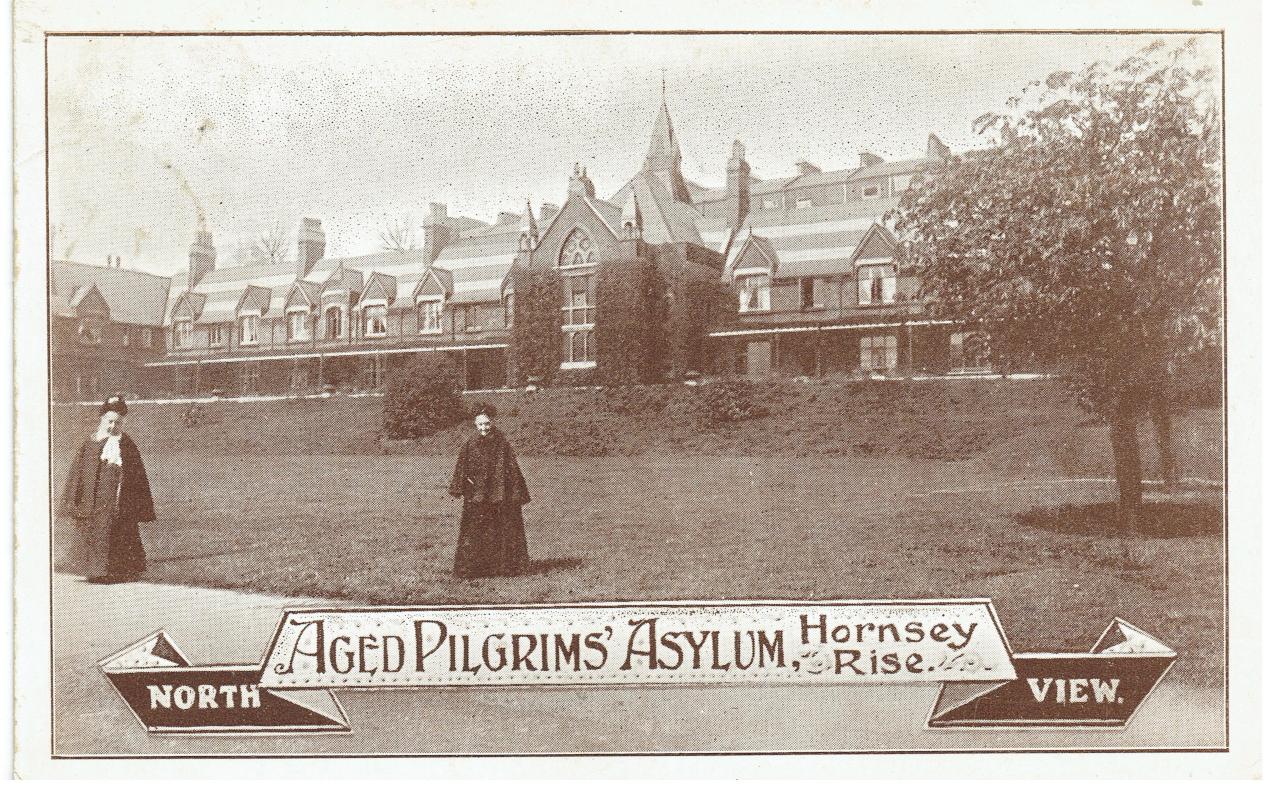This almshouse (called an asylum) is located just outside Hornsey Parish and is part of the late Hugh Garnsworthy’s postcard collection gifted to the Society.
Fourteen postcards of which provide a complete record of the Asylum buildings from every direction. The Archive holds copies also of two 1870s articles from The Builder, both with beautiful engravings of the building at different stages of its occupancy.

The Aged Pilgrims’ Friend Society, founded in 1807 provided pensions for, ‘aged and infirm Christian poor of the age of sixty and above whose income does not exceed five shillings per week’. Supporters were Lord Shaftesbury, Baptist preacher Charles H Spurgeon and William Wilberforce who became the Society’ vice-president until his death in 1833. In the late 1820s the Society turned its attention to the many elderly who lived in very inadequate housing and provided its first asylum/almshouse, in Camberwell.
The Builder Article
In 1871 the Aged Pilgrims’ Friend Society opened its second Asylum on the corner of Hazellville Road and St John’s Road (now St John’s Way), Hornsey Rise, next door to the Islington Union Workhouse. The Asylum consisted of a two storey central block with two wings and a beautiful chapel in the north block with a central enclosure consisted of grassy slopes and terraces connected by flights of steps. The Builder, 12th November 1870, tells us that, ‘it provides accommodation for eighty pensioners…The design combines the corridor and cottage systems … All the corridors and staircases are fireproof… The materials are stock bricks … with dressings of Box stone.’ The architect, F Boreham, personally supervised construction by Messrs. Hill & Sons of Islington.
Further information is added in The Builder, 12th August 1876, ‘Recently, owing to the generous liberality of an old supporter of the Aged Pilgrims’ Friend Society… forty new rooms have been attached, a dining room, kitchen and new committee rooms have been added’. The new rooms provided each pensioner with, ‘a sitting room fitted with a cooker range, a recess for a bed, an inclosed scullery, with coal-box filled from the outside corridor, shelves, and cupboard. The dining room, reached by covered ways, is for the purpose of enabling the pensioners to dine together … for which the attached kitchens, with service hatch, scullery, larder etc. provides ample requisites’ Shades of what many a residential home provides today.
Postcard
The Asylum housed married couples as well as the unattached. Visitors were permitted. The back of the postcard showing the North View of the Asylum, has a 1906 postmark, and is addressed to Mrs Witham, 8 Osborne Rd, Palmers Green. The message reads, ‘Dear Friend we hope you and Gerty will spend the first afternoon you have time to come Love from both Your old friend A.E.B’. Beneath is this printed information: ‘1,649 Pensioners. 120 Inmates. £43 Daily Expenditure’. Such information helps to make Asylum life at the start of the 20th century ‘real’ for us. State pensions had not been introduced when the postcard was sent. The Old Age Pension Act 1908 gave state pensions to the over 70s with an income of less than £21 a year (see page …). Although a very small contribution to the redistribution of wealth, it was a move away from the old Poor Law and a landmark in the development of the Welfare State.
Current location
The Aged Pilgrims’ Asylum closed in 1973 and was demolished, along with the neighbouring workhouse, when the area was replaced by housing developments and play areas. If you are on the No. 41 bus as it turns into St John’s Way going to Archway you will see on your right Louise White House and part of the Hillside Estate where once stood for a hundred years the imposing (forbidding?) Aged Pilgrims’ Asylum.
Although the almshouses have gone the Pilgrims’ Friend Society continues to manage residential care homes and sheltered accommodation outside London. As with the Hornsey Parish Charities, the almshouse provision focused on in this chapter shows that, even in an altered form, charitable provision is still being made for the elderly and the vulnerable.
Image credits
Hornsey Historical Society